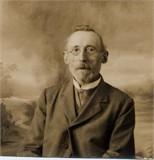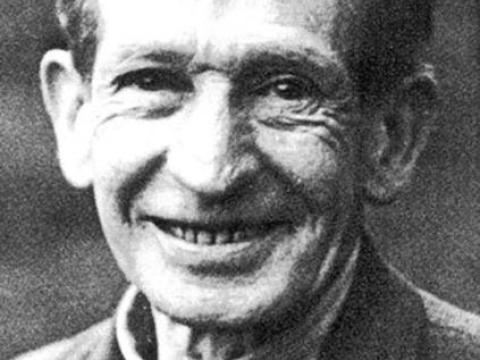A short biography of German anarchist George Stenzleit, active in London

“Always progressive in his outlook, unlike so many who in their youth are revolutionary and then turn back, he never became static or reactionary; but all his life kept his mind in touch with the best advanced thought on social and political subjects. It was this pleasing side of his character which accounts for the fact, that while he was really one of the “Old Guard” in our movement, he was at the same time quite up to date, becoming more definitely Anarchist as he advanced in years. His life and work stand out as a beacon, lighting the way for others, while it is an example worthy of being followed by our younger comrades”. John Turner
Georg Hermann Stenzleit was born in Wilpischen near Königsberg (now the Russian enclave of Kaliningrad) on 23rd July 1848. His father was a schoolmaster and he was apprenticed as and worked as a cabinet maker all his life. He married Pauline Ann Knoller and was to raise seven children with her. He was active in the Social Democratic Party in Berlin, where he got to know Johann Most, then on the left of the Party and chief editor of the Berliner Freien Presse. With the passing of the Anti-Socialist Laws, SPD members were expelled from Berlin (this was followed by expulsions of SPD members from other towns and cities) Stenzleit, who lived on the third floor of 13 Wrangelstrasse, was one of the first to be expelled from Berlin on 29th November 1878. Expulsion meant great hardship for those expelled and their families as they were robbed of their livelihoods. Hermann Grimpe, who organised a mutual assistance campaign for the expellees and their families and who was himself subsequently expelled, refers to Pauline Stenzleit’s wife, as being without means and requiring urgent help.
Stenzleit and his family made his way to London in 1879. There he became one of the most active members of the Communistische Arbeiter Bildungsverein (CABV)- Communist Workers' Educational Union- located in Grafton Street. He appears to have operated as a cabinet maker from 31 Cleveland Mews, Cleveland Street.
When Most himself turned up in London after a prison stretch and expulsion from Berlin, Stenzleit sought him out. Both were making the gradual trajectory from the left of social-democracy to anarchist communism. When Most set up his paper Freiheit (Freedom) which first appeared on January 4th 187, Stenzleit was one of the co-founders.
Stenzleit took the side of the Peukert faction during the Bruderkreig (Brothers War) which tore apart the German anarchist movement in 1887 thus breaking with Most and with Victor Dave.
Stenzleit appears to have been a fixer within the international anarchist movement in London. He acted as treasurer for Louise Michel's free school in Fitzrovia in 1892. He was a member of the Anarchist Socialist and Anti-Parliamentary Committee, together with Wess, Caplan, Nettlau, Perry (Presburg) and Malatesta which organised a huge public meeting on Tuesday 28th July 1895 to coincide with the International Socialist Congress in London, as well as a private meeting to organise the anarchist intervention within it two days before. It was alleged that he obtained a 21 year lease for the club of the International Workingmen’s Association at 83 Charlotte Street. It was he who introduced Nettlau to members of the Italian anarchist club at 2 Dean Street when the latter arrived in London in 1885. When Freedom’s type and materials were at risk of being seized by a landlord in August 1892 William Wess moved them under cover of darkness to Stenzleit’s house in Grafton Street. There Freedom was published ‘under the roof’ until February 1893.
He was a close friend of Otto Schreiber who arrived in London in the 1880s. Stenzleit, Schreiber and Wilhelm Werner attended Rudolf Rocker’s lectures at the CABV on the First International and encouraged him to turn these into a book. Stenzleit and Schreiber, convinced antimilitarists, attended the stormy meetings at the offices of Freedom where the pro-war Tcherkezov and the anti-war Malatesta were at loggerheads. When Schreiber died in the Knockaloe concentration camp on the Isle of Man in winter 1917, it was Stenzleit who attempted to save the books from the old CABV library that his friend had hidden at his house, but to no avail.
Stenzleit kept in close contact with the anarchist movement back in Germany, making several visits there. He appears to have returned to Germany in 1928 for a visit where he spoke at a meeting on the 18th August convened by the FAUD and the Anarchistischen Vereinigung Berlin (for this organisation see the libcom biography of Fritz Scherer). He was 80 years old at the time. Active up to the end, he died on 9th March1933 at Friends House and was buried on 13th March at Little Munden near Ware in Hertfordshire. His son, George Hermann Stenzleit junior, was also active in British anarchist circles.
Nick Heath
Sources:
Freedom Centenary Edition- A Hundred Years October 1886 to October 1986.
Turner, John. Obituary in Freedom , April 1933.
Photographs kindly supplied by Stenzleit’s great granddaughter, Katia.





Comments
Great bio, thanks for
Great bio, thanks for writing. Just one question, what was the "Brothers War" in the German anarchist movement about?
From Trunk bio here at
From Trunk bio here at libcom;
However Trunk and his fellow German anarchists were soon engulfed in an intense and bitter dispute know as the Bruderkreig, or Brothers War, which had been simmering since 1884. This complex split in the German movement was based on ideological positions, competing newspapers, and strong personalities, and was further clouded by the involvement of police spies.
In February 1887, Johann Neve was arrested by Belgian police while smuggling anarchist newspapers into Germany. As Andrew Carlson explains in Anarchism in Germany, “it was a route that Berlin police wanted to smash, and Neve was a person they wanted to imprison, but it took them several years of work and the assistance of several police spies before they were able to achieve these two goals.” After being thrown in a German jail, Neve wrote to Trunk that he had carved the date 1902 into his cell door—the year it would swing open and grant him freedom. It was the last letter anyone in the movement ever received from Neve, who died in police custody in 1896.
Neve’s imprisonment turned the anarchist’s political and literary debate into one of outright war. Accusations that Neve had fallen victim to a spy plot were rife, and friends quickly became enemies. Trunk initially found himself on the side of his Freiheit comrades such as Victor Dave—‘collectivists’ who were often at odds with anarchist communists like Josef Peukert and the Die Autonomie group. However Trunk—despite hiring a private investigator to determine where the Autonomie group’s money was coming from—later joined forces with Peukert and the group. He cited Dave’s overbearing and tyrannical behaviour as the reason for his defection.[9]
Thanks for the additional
Thanks for the additional info
the police spy responsible
the police spy responsible for Neve's arrest which escalated the Brothers War was Theodor Reuss, a police spy and bizarre figure who was later a close collaborator of Aleister Crowley